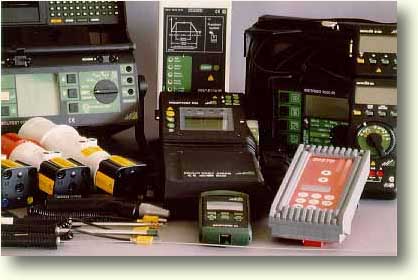
rev. 16.08.2001

 Since Spring 2001 we use a Kodak DC4800 digital camera. The image quality of this 3,1 megapixel camera is sufficent for most
applications. Only the storage card delivered with this camera limits the number of photos taken at full resolution to 1
(in words: one) at the first compression stage to 15.
But this may be changed by the purchase of a larger Compact Flash Card (CF Card). The original equipment contains a 16 MB-CF-Card.
These cards are available up to 128 MB which should eliminate these problems.
Since Spring 2001 we use a Kodak DC4800 digital camera. The image quality of this 3,1 megapixel camera is sufficent for most
applications. Only the storage card delivered with this camera limits the number of photos taken at full resolution to 1
(in words: one) at the first compression stage to 15.
But this may be changed by the purchase of a larger Compact Flash Card (CF Card). The original equipment contains a 16 MB-CF-Card.
These cards are available up to 128 MB which should eliminate these problems.
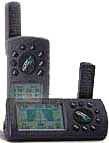 A real 12 channel parallel GPS-receiver. With excellent reception qualities, which make it possible
to get position data even in urban regions, so that there are practically no restriction in use and
operation.
A real 12 channel parallel GPS-receiver. With excellent reception qualities, which make it possible
to get position data even in urban regions, so that there are practically no restriction in use and
operation.
 Since early spring 1999 a series of CD-ROM's for Germany is, at reasonable cost, available. One CD-ROM for each of Germanys states
except Bavaria, which spreads its maps on two CDs. The maps contained on these CD-ROMs have a scale of
Since early spring 1999 a series of CD-ROM's for Germany is, at reasonable cost, available. One CD-ROM for each of Germanys states
except Bavaria, which spreads its maps on two CDs. The maps contained on these CD-ROMs have a scale of  Sometimes you will find the need of an optical enlargement of destruction traces on evidence to be able to determin the origin and nature
of the destruction. Further, you will want to be able to document, what you could see through your optical enlargement device.
Microscopy is an high priced task, as the instuments are regular not sold as complete consumer products. So, for a correct solution
you need a certain knowledge to compile the necessary equipment from all the parts that belong to the microscopy system you have
choosen. The available information material should be studied extensively and finally you should ask your sales representative of
the manufacturer you have choosen all those things that are not clearly understood.
Sometimes you will find the need of an optical enlargement of destruction traces on evidence to be able to determin the origin and nature
of the destruction. Further, you will want to be able to document, what you could see through your optical enlargement device.
Microscopy is an high priced task, as the instuments are regular not sold as complete consumer products. So, for a correct solution
you need a certain knowledge to compile the necessary equipment from all the parts that belong to the microscopy system you have
choosen. The available information material should be studied extensively and finally you should ask your sales representative of
the manufacturer you have choosen all those things that are not clearly understood.
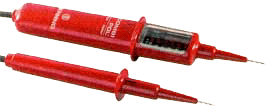 Voltage testers are not necessary if you already have a multimeter, but they can simplify your life if you
only want to test whether a powerline is powered or not. An other advantage is, that your expensive multimeter
can stay in its transportationbox without getting dirty. These testers are normally in a rugged case and can withstand
a use under hardest conditions and all this for real low prices. The tester we use is from Benning. The model CombiPol
solar contains a solar cell so that even simple continuity checks may be performed and is protected accordin to IP 65.
The maximum voltage is 650 volts. Voltage levels of 12, 50, 120, 230, 400, 690 volts are displayed by leds. Polarity
check for DC and phase/neutral detection for AC is possible.
Voltage testers are not necessary if you already have a multimeter, but they can simplify your life if you
only want to test whether a powerline is powered or not. An other advantage is, that your expensive multimeter
can stay in its transportationbox without getting dirty. These testers are normally in a rugged case and can withstand
a use under hardest conditions and all this for real low prices. The tester we use is from Benning. The model CombiPol
solar contains a solar cell so that even simple continuity checks may be performed and is protected accordin to IP 65.
The maximum voltage is 650 volts. Voltage levels of 12, 50, 120, 230, 400, 690 volts are displayed by leds. Polarity
check for DC and phase/neutral detection for AC is possible.
Precision Multimeter
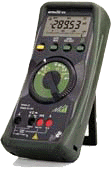 Precision multimeters give you more accurate values, have an extended metering range, will give you a more comfortable
use, may normally be connected to a computer and offer in most cases other surplus. Prices for such an instrument will
start at about ten times of that you have to pay for a simple multimeter. Regular calibration of those instruments is highly
advised, as otherwise there will be not much precision left after a certain time. The periods for recalibration depend on
the usage and storage conditions of these devices.
Precision multimeters give you more accurate values, have an extended metering range, will give you a more comfortable
use, may normally be connected to a computer and offer in most cases other surplus. Prices for such an instrument will
start at about ten times of that you have to pay for a simple multimeter. Regular calibration of those instruments is highly
advised, as otherwise there will be not much precision left after a certain time. The periods for recalibration depend on
the usage and storage conditions of these devices.
The precision multimeter we use is a Gossen-Metrawatt MetraHit 18s.
The voltage range is 300 mV to 1000 V (TRMS Crest-factor max. 5), the current range is 300 µA to 10 A (TRMS
Crest-factor max. 5), resistance 300 Ohms to 30 MOhms, capacity 3 nF to 10000 µF, frequency 300 Hz to 100 kHz,
temperature -200°C to +850°C (Pt 100 / Pt 1000), counter and time period, data and min/max memory, digital display
±31000 digit, analogue display ±35 scaleparts, automatic scaling. The accuracy is ±0.05% of measured value
±3 digits.
The instrument is enhanced by a 6-channel serial-bus memory interface (SI 232) which makes it possible to store measured values
offline and to connect the instrument to a computer. If connected to the computer while mesurements are performed, the instrument
may be partially controlled by the computer. The memory module is electicalliy insulated by an infrared interface. The software allows
to use the instrument as datalogger, Yt-writer, or two instruments as XY-writer.
Installation Tester
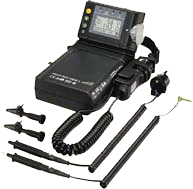 Installation tester for electrical installations according to DIN-VDE 0100 part 610, IEC 64-8, and HD 364-6-61.S1. This is a multipurpose
meter with some intelligence, that allows to check electrical installations for all protection measures that are necessary according to
several national codes. These measurements are prepared by internal calculations to receive the necessary values without manual
calculations. Thought for electricians to check out new, changed or enhanced installations, this instrument may also be useful in fire
investigations and (criminal) technical investigations, to find and check mainpulated circuits intended to set fire or to kill somebody, or
for the examination of accidental fatalities or injuries due to electric shock.
Installation tester for electrical installations according to DIN-VDE 0100 part 610, IEC 64-8, and HD 364-6-61.S1. This is a multipurpose
meter with some intelligence, that allows to check electrical installations for all protection measures that are necessary according to
several national codes. These measurements are prepared by internal calculations to receive the necessary values without manual
calculations. Thought for electricians to check out new, changed or enhanced installations, this instrument may also be useful in fire
investigations and (criminal) technical investigations, to find and check mainpulated circuits intended to set fire or to kill somebody, or
for the examination of accidental fatalities or injuries due to electric shock.
The instrument we use is from Gossen-Metrawatt the model ProfiTest 0100 S, enhanced by the printer/memory/interfacemodule
ProfiTest PSI and enhanced by the RCD-blocker ProfiSkip, which is used to be able to perform measurements that that would otherwise
trip an installed residual current device (RCD). This equipment makes it possible to perform all necessary measurements without noting
anything, and to printout the results directly on location and to transfer the sampled data to a computer. The memory is grouped that way
that data for every circuit, appartment and house measured can be identified afterwards. Adapters for poweroutlets in Germany,
Switzerland, Great Britan, Italy and Denmark are availabe as well as adapters for tri-phase-systems with EC-poweroutlets 16A, 32A,
and 63A. A good but expensive tool, which needs extensive and repeated training for correct application
Appliance Tester
 Appliance checkers are used on the other side of the poweroutlet. These are instruments to check the electrical security of movable
electrical appliances after repair or change according to DIN VDE 0701 and 702.
Appliance checkers are used on the other side of the poweroutlet. These are instruments to check the electrical security of movable
electrical appliances after repair or change according to DIN VDE 0701 and 702.
The instrument we use is the SecuTest 0701/0702 S from Gossen-Metrawatt enhanced by the printer/memory module SecuTest PSI.
Automatic recognition of protection class of the appliances as well as automated measurements are possible. An adapter for the test of
single phase extension cords is available for this instrument, as well as an adapter for three phase plugs and CEE-plugs. An RS-232 interface
is standard on this instrument.
Insulation Tester
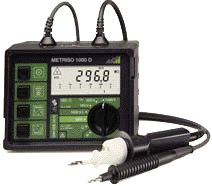 Insulation meters, sometimes also called meggers, are used to check the insulation resistance at higher voltages.
Insulation meters, sometimes also called meggers, are used to check the insulation resistance at higher voltages.
Though both instruments described above (installation and appliance tester) are capable to perform standard insulation
metering at 500 V, this instrument is a useful supplement as it offers insulation measurement at up to 1000 V. The instrument
we choose is the Gossen-Metrawatt Metriso 1000 IR. It offer three different measurement voltages (250, 500, and 1000 V).
The measurement range is 0 to 30 giga ohm. This shows that the name 'megger' is no longer correct and should now be
'gigger'...
E/M-Field Metering
 E/M-field metering makes it possible to find out whether alternating electric and/or magnetic fields are present in the environment. This
makes it, for examlple, possible to determin, whether induction effects could have lead to an ignition.
E/M-field metering makes it possible to find out whether alternating electric and/or magnetic fields are present in the environment. This
makes it, for examlple, possible to determin, whether induction effects could have lead to an ignition.
We use the adapter FMA 1 from Gossen-Metrawatt, which may be attached to the precision multimeter MetraHit 18s.
This combination offers a range from 0,0 to 30000.0 V/m with a resolution of 0.1 V/m for alternating electric fields and
a range of 0.0 to 300.0 µT for alternating magnetic fields with a resolution of 0.1 µT in the frequency range from
16 Hz to 100 kHz. The basic accuracy of this adapter is ± 10 % of measured value for alternating electric fileds and
± 5 % of measured value for alternating magnetic fields.
The adapter is equipped with an IR-interface.
 Detection of powered and non-powered cables in the ground or in walls is possible with the set of two tranmitters and a receiver. One of
those transmitters is battery powered, for the connection to non-powered cables, while the other, intended for the connection to powered
cables, is powered by the cable itself. The function is identical with both transmitters. The transmitter puts an RF-signal on the cable, which
can be detected via the receiver module. By selecting the transmitter signal strength and the receiver sensitivity, a wide detection range is
covered by this very useful tool.
Detection of powered and non-powered cables in the ground or in walls is possible with the set of two tranmitters and a receiver. One of
those transmitters is battery powered, for the connection to non-powered cables, while the other, intended for the connection to powered
cables, is powered by the cable itself. The function is identical with both transmitters. The transmitter puts an RF-signal on the cable, which
can be detected via the receiver module. By selecting the transmitter signal strength and the receiver sensitivity, a wide detection range is
covered by this very useful tool.
Distances of up to two meters are no problem, as well as you may find out a single wire within a cable. The instrument set is made in the USA
and distributed in Germany via Gossen-Metrawatt and ABB.
 Laser distance meters have the advantage to be able to see the point to which you are measuring.
They are precise and easy to use and you may measure distances from 20 centimeters up to 140 meters
with nearly the same precision. There are naturally also some disadvantages, as those
meters are quite expensive, and as laser beams from a certain strength on are dangerous, some precautions
have to be taken for their operation.
Laser distance meters have the advantage to be able to see the point to which you are measuring.
They are precise and easy to use and you may measure distances from 20 centimeters up to 140 meters
with nearly the same precision. There are naturally also some disadvantages, as those
meters are quite expensive, and as laser beams from a certain strength on are dangerous, some precautions
have to be taken for their operation.
 Laser beams are dangerous -Full stop-. Whether the possible dangers are probable, less probable, or improbable is of no importance and everything
feasible should be done to exclude dangers wherever they are possible. This is my oppinion, as even the improbable happens.
I state this, as it reflects my point of view and makes it easier to understand the following argumentation.
Laser beams are dangerous -Full stop-. Whether the possible dangers are probable, less probable, or improbable is of no importance and everything
feasible should be done to exclude dangers wherever they are possible. This is my oppinion, as even the improbable happens.
I state this, as it reflects my point of view and makes it easier to understand the following argumentation.
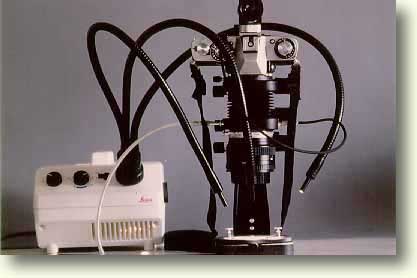
 The basic equipment you should have is a VHS-videorecorder to be able to view videocassettes for education purposes published by several
organizations and enterprises. More desireable is a multistandard VCR, to be able to playback at least NTSC and PAL videos.
The basic equipment you should have is a VHS-videorecorder to be able to view videocassettes for education purposes published by several
organizations and enterprises. More desireable is a multistandard VCR, to be able to playback at least NTSC and PAL videos. Far better as the above mentioned camcorders are digital camcorders. The first big advantage is that you don't have to make a decision between different
systems. As far as I know all manufacturers of digital video camcorders use the same system. Finally, though they needed nearly twenty years to understand.
But now back to the real needs. The smaller the unit is, the better, as the quality the smallest units offer, is sufficient for our purposes, though the bigger units
with three-chip-optics reach the performance of professional tv equipment, which cannot be achieved with the small single chip units, but we are not tv camera men,
we are fire investigators. The images you will get from these digital camcorder are are of an incredible good quality compared to the older systems and the versatility
of the supplemntal functions of those systems are already so far advanced, that you will rarely find something you whish to be added to them.
Far better as the above mentioned camcorders are digital camcorders. The first big advantage is that you don't have to make a decision between different
systems. As far as I know all manufacturers of digital video camcorders use the same system. Finally, though they needed nearly twenty years to understand.
But now back to the real needs. The smaller the unit is, the better, as the quality the smallest units offer, is sufficient for our purposes, though the bigger units
with three-chip-optics reach the performance of professional tv equipment, which cannot be achieved with the small single chip units, but we are not tv camera men,
we are fire investigators. The images you will get from these digital camcorder are are of an incredible good quality compared to the older systems and the versatility
of the supplemntal functions of those systems are already so far advanced, that you will rarely find something you whish to be added to them. These miniature video cameras are very useful as inspection devices that grant a view into areas which are not accessible in other ways. A very
important disadvantage of these devices is their extremly high price. (You'll get two ordinary camcorders for the price of such a unit.) Equipped with
a 12V-battery and a small short range tv-transmitter you will have a cablleless handy spy unit. The camera unit on the picture is a Sony XC-999P. The
unit is complete and needs for operation only a 12V power supply and a video monitor plugged into the connector on its back. Its dimensions are
22 mm x 22 mm x 120 mm and the weight is 99 g (without lens). It is equipped with a 1/2-inch-CCD-sensor. There is an other model available, the XC-777P.
This one is equipped with a 1/3-inch-CCD-sensor. Its dimensions are 22 mm x 22 mm x 89 mm and the weight is 75 g. Five different lenses, a C-mount
adaptor, and four extension rings are available for these camera modules (f1.8 / 3.5 mm, f2.0~f128 / 7 mm, f1.4 / 6 mm, f1.4 / 12 mm, and f2.0 / 8.9 mm).
These miniature video cameras are very useful as inspection devices that grant a view into areas which are not accessible in other ways. A very
important disadvantage of these devices is their extremly high price. (You'll get two ordinary camcorders for the price of such a unit.) Equipped with
a 12V-battery and a small short range tv-transmitter you will have a cablleless handy spy unit. The camera unit on the picture is a Sony XC-999P. The
unit is complete and needs for operation only a 12V power supply and a video monitor plugged into the connector on its back. Its dimensions are
22 mm x 22 mm x 120 mm and the weight is 99 g (without lens). It is equipped with a 1/2-inch-CCD-sensor. There is an other model available, the XC-777P.
This one is equipped with a 1/3-inch-CCD-sensor. Its dimensions are 22 mm x 22 mm x 89 mm and the weight is 75 g. Five different lenses, a C-mount
adaptor, and four extension rings are available for these camera modules (f1.8 / 3.5 mm, f2.0~f128 / 7 mm, f1.4 / 6 mm, f1.4 / 12 mm, and f2.0 / 8.9 mm).
Ingenieurbüro Frank Markmann
Gottfried-Blum-Weg 4
D-88639 Wald
Germany
Phone: +49-(0)-7578-933141
Fax: (on request)